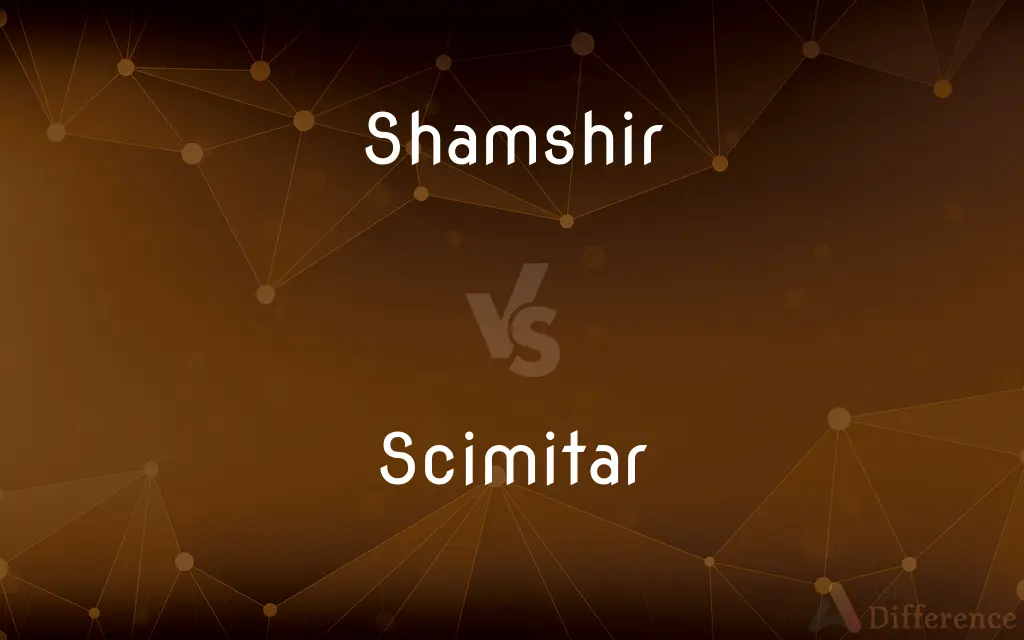Shamshir vs. Scimitar — What's the Difference?
Edited by Tayyaba Rehman — By Urooj Arif — Updated on April 22, 2024
The shamshir features a more pronounced curve and a narrow blade, designed primarily for slashing, while the scimitar includes a wider range of curved swords from the Middle East and Central Asia, often broader and less uniformly curved.

Difference Between Shamshir and Scimitar
Table of Contents
ADVERTISEMENT
Key Differences
The shamshir, originating from Persia, is distinguished by its deep curvature and typically narrow, pointed blade, optimized for slicing or slashing motions in cavalry combat. On the other hand, the scimitar is a broader term encompassing various curved swords from the Middle East and Central Asia, including but not limited to the Persian shamshir. This comparison highlights how the shamshir is a specific type of scimitar with distinct characteristics, whereas the scimitar refers to a wider category of swords with variations in size, shape, and curvature.
The shamshir's design facilitates a pulling cut, relying on momentum and speed, which was highly effective from horseback. Conversely, scimitars can vary in their curvature and edge design, catering to different fighting styles and functionalities, from heavy chopping blades to lighter slashing ones.
In terms of historical usage, the shamshir was a staple in Persian military gear from the 16th century onwards, often associated with elite cavalry units. Scimitars, however, were used across a wide geographical area, from the Ottoman Empire to the Indian subcontinent, reflecting a rich diversity in blade smithing traditions across these regions.
Art and culture also depict these swords differently; the shamshir is often portrayed in Persian miniatures and art as a symbol of Persian martial prowess. In contrast, the scimitar appears in a variety of cultural artifacts, from Arabian Nights tales to decorations in palaces across the Middle East, often symbolizing the warrior class.
In modern times, both swords have transcended their original martial contexts to become ceremonial or decorative pieces. Collectors and historical enthusiasts seek the shamshir for its beauty and craftsmanship, while the scimitar is admired for its wide cultural significance and variety in designs.
ADVERTISEMENT
Comparison Chart
Origin
Persia
Middle East, Central Asia
Blade Shape
Deep curve, narrow and pointed
Varies, generally curved
Use
Slashing from horseback
Diverse, including slashing and chopping
Historical Association
Persian cavalry
Broad use across multiple empires
Symbolism
Persian military prowess
Warrior class, broad cultural significance
Compare with Definitions
Shamshir
A deeply curved sword from Persia.
The museum displayed a shamshir, renowned for its sharpness and curve.
Scimitar
Used across a wide geographical area.
Scimitars were used from the Ottoman Empire to the Indian subcontinent.
Shamshir
Designed primarily for slashing.
The cavalry used the shamshir effectively in their fast-paced assaults.
Scimitar
A broad term for Middle Eastern curved swords.
His collection of scimitars includes examples from several different cultures.
Shamshir
Symbol of Persian martial heritage.
In ceremonies, the shamshir represents Persian historical military achievements.
Scimitar
Varies widely in design and use.
Some scimitars in the exhibit were designed for chopping, others for slashing.
Shamshir
Featured in Persian art and culture.
Persian miniatures often depict heroes wielding a shamshir.
Scimitar
Appears in folklore and stories.
The scimitar is a common weapon in tales of Arabian adventures.
Shamshir
Collectible item for its craftsmanship.
He collected antique shamshirs, each with a unique handle and blade design.
Scimitar
Often ornately decorated.
The ceremonial scimitar was adorned with jewels and intricate engravings.
Shamshir
A shamshir (Persian: شمشیر) is a type of Persian/Iranian sword with a radical curve. The name is derived from the shamshīr, which means "sword" in the Persian language.
Scimitar
A scimitar ( or ) is a backsword or sabre with a curved blade typically associated with Middle Eastern, South Asian, or North African cultures.
Shamshir
A Persian curved blade without a pommel.
Scimitar
A curved Asian sword with the edge on the convex side.
Scimitar
A sword of Persian origin that features a curved blade.
Scimitar
A long-handled billhook.
Scimitar
(transitive) To strike or slice with, or as if with, a scimitar.
Scimitar
A curved oriental saber; the edge is on the convex side of the blade
Common Curiosities
How does the scimitar differ in its uses across cultures?
The scimitar differs in its uses across cultures, from heavy chopping in some regions to light slashing in others, reflecting local martial practices.
What makes the shamshir distinct in its design compared to other scimitars?
The shamshir is distinct for its deeper curvature and narrower, more pointed blade, which are optimized for effective slashing.
How are scimitars and shamshirs perceived in modern times?
In modern times, both scimitars and shamshirs are often perceived as ceremonial or decorative pieces, with historical enthusiasts appreciating their craftsmanship and cultural significance.
How have shamshirs and scimitars influenced modern depictions of historical and fantasy battles?
Shamshirs and scimitars have heavily influenced modern depictions of historical and fantasy battles in films, literature, and video games, often portrayed as exotic and mystical weapons wielded by skilled warriors.
What is the primary function of a shamshir in combat?
The primary function of a shamshir in combat is for slashing, utilizing its curved blade.
Can a shamshir be considered a type of scimitar?
Yes, a shamshir can be considered a specific type of scimitar, with unique features that distinguish it from other swords in the scimitar category.
What materials are typically used to make a shamshir?
Shamshirs are typically made from high-quality steel, often with elaborately decorated handles using materials like gold, silver, or ivory for ceremonial versions.
What is the historical significance of scimitars in warfare?
Scimitars have significant historical value in warfare, particularly in the Middle East and Central Asia, where they were essential for cavalry and infantry due to their effective cutting ability and ease of use on horseback.
Are there any notable differences in the balance and handling between a shamshir and other types of scimitars?
The shamshir is known for its exceptional balance and light weight, which allows for quick, fluid motions primarily from horseback, while other scimitars might be heavier or balanced differently to accommodate different combat styles, including on-foot engagements.
What role do shamshirs and scimitars play in cultural ceremonies today?
Today, shamshirs and scimitars often play symbolic roles in cultural ceremonies across their regions of origin, used in military parades, traditional dances, and as part of official regalia in ceremonial contexts to honor historical heritage and martial prowess.
Share Your Discovery

Previous Comparison
Obsidian vs. Onyx
Next Comparison
Deprioritised vs. DeprioritizedAuthor Spotlight
Written by
Urooj ArifUrooj is a skilled content writer at Ask Difference, known for her exceptional ability to simplify complex topics into engaging and informative content. With a passion for research and a flair for clear, concise writing, she consistently delivers articles that resonate with our diverse audience.
Edited by
Tayyaba RehmanTayyaba Rehman is a distinguished writer, currently serving as a primary contributor to askdifference.com. As a researcher in semantics and etymology, Tayyaba's passion for the complexity of languages and their distinctions has found a perfect home on the platform. Tayyaba delves into the intricacies of language, distinguishing between commonly confused words and phrases, thereby providing clarity for readers worldwide.
















































